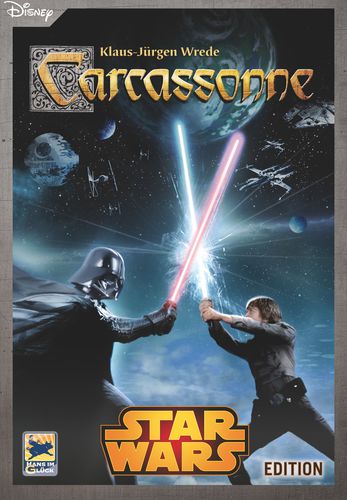Fuji Flush is my most-played game of the year!
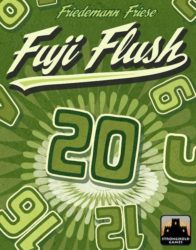
As the days tick down for 2018, I was glancing over my list of games played this year and noticed an injustice.
I’ve neglected to post a review of my most-played game of the year!
How can that be?
It’s a shame really.
But there’s still time to right that wrong.
It’s time for Fuji Flush to take its well-deserved place among the great family games we’ve reviewed!
(And letting you know about it in time to get it for your family for Christmas.)
How to play Fuji Flush
The goal of Fuji Flush, by Stronghold Games, is to be the first player to get rid of your hand of cards (valued 2-20). The catch is in how you can get rid of your cards.
Each player begins with a hand of 6 cards (or 5 cards in 7- and 8-player games). Players take turns in which they choose 1 card from their hand to play in front of them.
Then the next player does the same.
There are no restrictions on which card a player can choose to play.
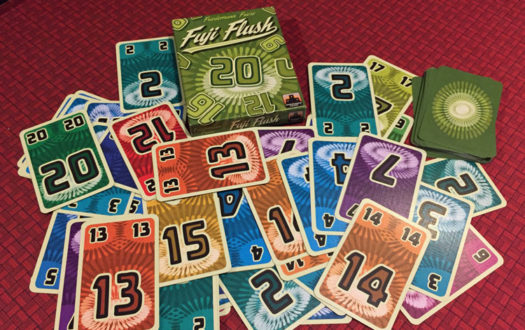
If a player plays a card that’s of higher value than cards played by prior players, it “beats” those cards. All players who have played a lower value card must “flush” their played card. That means they must discard the card and draw a replacement card to their hand.
For example, if player A plays a card of value 9 and player B plays a card of value 7, nothing happens. But if player C then plays a card of value 8, then player B has their card “flushed”. Player A is still okay with their 9 in front of them because it’s higher than the 8 just played.
If a card is still in front of a player when it comes back around to their turn, they have successfully pushed their card through and it is discarded without drawing a replacement. That’s how players get rid of their cards.
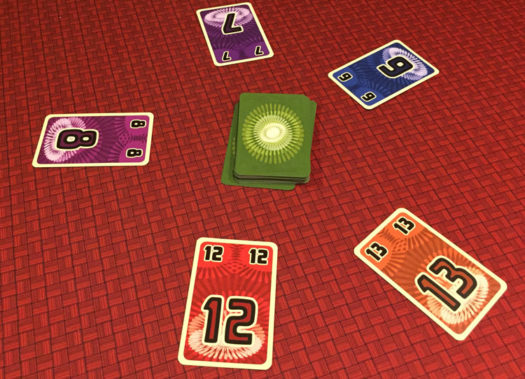
That player then continues by playing another card from their hand.
But there’s a bit more to the game than that.
If a player plays a card that’s the same value of a card in front of another player, those cards are combined in value. If that combined value is higher than other cards played, those other cards are “flushed”.
For example, if player A plays a 15 and player B plays an 8, nothing happens. But if player C then plays an 8, the two 8’s are combined to now make 16 – which will “flush” the 15. If player D also plays an 8, the combined value is now 24.
If the combined valued cards aren’t flushed, and it gets back around to the first player who played a card of that value pushes the card through, all players who played that same value also push their cards through. Thus, by combining card values this way, multiple players may successfully discard their cards without drawing replacements.
In the example above, if it gets back to player B without their card being flushed, they have successfully pushed it through. They discard their 8 card as does player C and D (who also played 8’s).
Play continues in this manner until one player successfully gets their last card pushed through and discards it for the win!
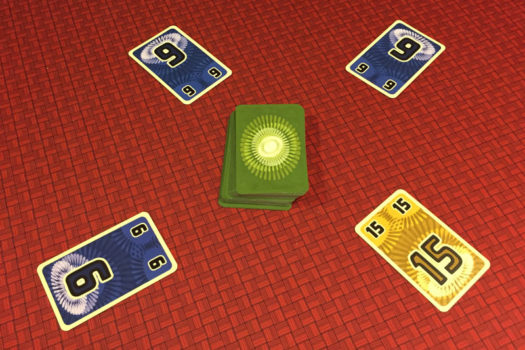
Can the whole family enjoy Fuji Flush?
Fuji Flush is a terrific game for the whole family to enjoy together. As long as you understand your numbers and simple addition, you can enjoy playing Fuji Flush.
Being a quick game to play is one reason why Fuji Flush has been my most-played game of the year. But that’s not the only reason.
Even if a game is quick, if it isn’t fun to play, it won’t hit the table again. Such is not the case with Fuji Flush.
Fuji Flush is also very addicting.
I don’t think we’ve ever played less than 3 games when it hits the table. It’s just so easy to shuffle and play again.
Because there’s a heavy element of luck involved in the game, many players call for a rematch at games end.
The distribution of the card values is also key to the game play and what compels us to keep playing. The 90 cards are numbered 2-20. There are 16 x 2’s, 12 x 3’s, 9 x 4’s, 8 x 5’s, 6 x 6’s and 7’s, 5 x 8’s, 4 x 9’s, 10’s and 11’s, 3 x 12’s, 13’s and 14’s, 2 x 15’s, and 1 of each from 16 to 20. With 2’s being so plentiful, there are plenty of attempts at getting them to stack around the table to be able to get rid of them.
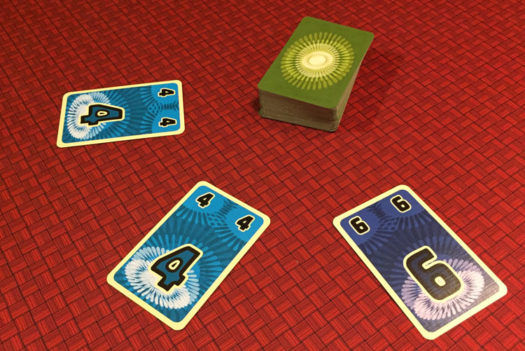
Fuji Flush is also a game that plays well no matter the number of players. The game allows for 3 to 8 players and we’ve enjoyed it at all counts. Even with 8 players the game moves along very quickly without any down time.
That’s partially because there’s only one thing to do on your turn – play a card. But it’s also because players are watching what the other players play in hopes that they can play similarly valued cards, so they can stack and then all clear them together.
Since it’s a deck of only 90 cards, it’s also very portable. We’ve played Fuji Flush in many different locations and with us on vacation.
Because of its light nature, it’s also a good game to play while maintaining family conversations around a table and just enjoying time together.
How does Fuji Flush score on our “Let’s Play Again” game meter?
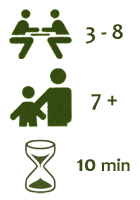 Do I really need to answer this question?
Do I really need to answer this question?
If it’s not yet obvious, Fuji Flush maximizes the gauge on our “let’s play again” game meter.
With Christmas break coming up and extended family members gathering, you can bet we still have many games of Fuji Flush upcoming before the end of the year.
Grab a deck of these colorful cards for your family. Fuji Flush will make a great stocking stuffer for Christmas.




